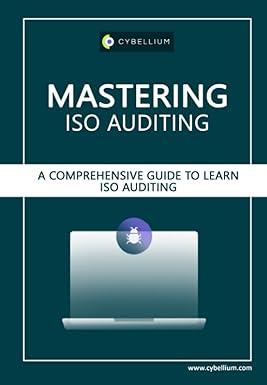Question
We need to evaluate a project for the production of socks, which requires an initial investment of $50,000,000, of which 80% corresponds to depreciable fixed
"We need to evaluate a project for the production of socks, which requires an initial investment of $50,000,000, of which 80% corresponds to depreciable fixed assets and 20% to working capital. The unit production cost is $10,000, and a unit sales price of $13,500 is estimated. The market study revealed a potential demand of 20,000 units for the first year. The fixed assets are depreciated straight-line over a useful life of 10 years. Operating expenses are estimated at $4,000,000 for the first year, and fixed costs amount to $10,000,000 for the first year. The following increases are estimated: sales 2% annually, variable unit cost 3% annually, unit sales price 3% annually, operating expenses 6% annually, fixed costs 5% annually. The project has a useful life of 5 years.
1. Build the project's cash flow.
To build the project's cash flow, we need to calculate the revenues and expenses for each year during the project's useful life (5 years). We will start with the provided information and apply the annual increments for each relevant variable. Here is the project's cash flow:
Year 1: Revenues: Sales = Potential demand x Unit sales price Sales = 20,000 x $13,500 = $270,000,000 Expenses: Total production cost = Potential demand x Unit production cost Total production cost = 20,000 x $10,000 = $200,000,000 Operating expenses = $4,000,000 Fixed costs = $10,000,000 Depreciation = (Total fixed assets cost) / (Useful life in years) Depreciation = ($40,000,000) / 10 = $4,000,000 Net Cash Flow: Net Cash Flow = Revenues - Operating expenses - Fixed costs - Depreciation Net Cash Flow = $270,000,000 - $4,000,000 - $10,000,000 - $4,000,000 = $252,000,000
Year 2 to Year 5: We will apply the annual increments to the relevant variables: - Sales increase: 2% annually - Variable unit cost increase: 3% annually - Unit sales price increase: 3% annually - Operating expenses increase: 6% annually - Fixed costs increase: 5% annually
Year 2: Revenues = Sales (Year 1) x (1 + Sales increase) Revenues = $270,000,000 x (1 + 0.02) = $275,400,000 Expenses: Total production cost = Potential demand x Unit production cost (Year 1) x (1 + Variable unit cost increase) Total production cost = 20,000 x $10,000 x (1 + 0.03) = $206,000,000 Operating expenses = Operating expenses (Year 1) x (1 + Operating expenses increase) Operating expenses = $4,000,000 x (1 + 0.06) = $4,240,000 Fixed costs = Fixed costs (Year 1) x (1 + Fixed costs increase) Fixed costs = $10,000,000 x (1 + 0.05) = $10,500,000 Depreciation = $4,000,000 (remains constant throughout the project's useful life) Net Cash Flow = Revenues (Year 2) - Operating expenses (Year 2) - Fixed costs (Year 2) - Depreciation (Year 2) Net Cash Flow = $275,400,000 - $4,240,000 - $10,500,000 - $4,000,000 = $256,660,000
Year 3: Revenues = Sales (Year 2) x (1 + Sales increase) Revenues = $275,400,000 x (1 + 0.02) = $281,908,000 Expenses: Total production cost = Potential demand x Unit production cost (Year 2) x (1 + Variable unit cost increase) Total production cost = 20,000 x $10,000 x (1 + 0.03) = $212,180,000 Operating expenses = Operating expenses (Year 2) x (1 + Operating expenses increase) Operating expenses = $4,240,000 x (1 + 0.06) = $4,486,400 Fixed costs = Fixed costs (Year 2) x (1 + Fixed costs increase) Fixed costs = $10,500,000 x (1 + 0.05) = $11,025,000 Depreciation = $4,000,000 (remains constant throughout the project's useful life) Net Cash Flow = Revenues (Year 3) - Operating expenses (Year 3) - Fixed costs (Year 3) - Depreciation (Year 3) Net Cash Flow = $281,908,000 - $4,486,400 - $11,025,000 - $4,000,000 = $262,396,600
Year 4: Revenues = Sales (Year 3) x (1 + Sales increase) Revenues = $281,908,000 x (1 + 0.02) = $288,546,160 Expenses: Total production cost = Potential demand x Unit production cost (Year 3) x (1 + Variable unit cost increase) Total production cost = 20,000 x $10,000 x (1 + 0.03) = $218,746,400 Operating expenses = Operating expenses (Year 3) x (1 + Operating expenses increase) Operating expenses = $4,486,400 x (1 + 0.06) = $4,750,464 Fixed costs = Fixed costs (Year 3) x (1 + Fixed costs increase) Fixed costs = $11,025,000 x (1 + 0.05) = $11,576,250 Depreciation = $4,000,000 (remains constant throughout the project's useful life) Net Cash Flow = Revenues (Year 4) - Operating expenses (Year 4) - Fixed costs (Year 4) - Depreciation (Year 4) Net Cash Flow = $288,546,160 - $4,750,464 - $11,576,250 - $4,000,000 = $268,219,446
Year 5: In the fifth year, the project ends, and only the operating expenses, fixed costs, and depreciation corresponding to that year are included. Operating expenses = Operating expenses (Year 4) x (1 + Operating expenses increase) Operating expenses = $4,750,464 x (1 + 0.06) = $5,027,492.64 (approximately) Fixed costs = Fixed costs (Year 4) x (1 + Fixed costs increase) Fixed costs = $11,576,250 x (1 + 0.05) = $12,155,062.50 (approximately) Depreciation = $4,000,000 (remains constant throughout the project's useful life) Net Cash Flow =
0 (no revenues) - Operating expenses (Year 5) - Fixed costs (Year 5) - Depreciation (Year 5) Net Cash Flow = 0 - $5,027,492.64 - $12,155,062.50 - $4,000,000 -$21,182,555.14 (approximately)"
WITH POINT 1 ALREADY GIVEN, RESOLVE POINT 2 CORRECTLY AND WELL BREAKDOWN.
2.- Calculate the IRR (Internal Rate of Return) and determine if the project is profitable or not, considering an opportunity rate of 30%
Step by Step Solution
There are 3 Steps involved in it
Step: 1

Get Instant Access to Expert-Tailored Solutions
See step-by-step solutions with expert insights and AI powered tools for academic success
Step: 2

Step: 3

Ace Your Homework with AI
Get the answers you need in no time with our AI-driven, step-by-step assistance
Get Started


